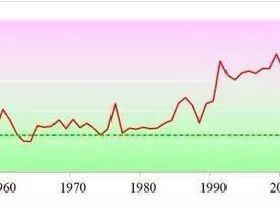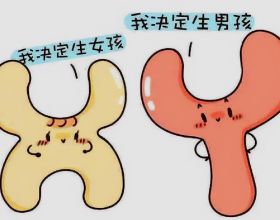英國的一項研究發現,兄弟多的男性更可能生兒子,而姐妹多的男性則更可能生女兒。
A Newcastle University study involving thousands of families is helping prospective parents work out whether they are likely to have sons or daughters.
英國紐卡斯爾大學一項有千萬家庭參與的研究能夠幫助準父母預測孩子性別。
The work by Corry Gellatly, a research scientist at the university, has shown that men inherit a tendency to have more sons or more daughters from their parents. This means that a man with many brothers is more likely to have sons, while a man with many sisters is more likely to have daughters.
科裡·格拉特利是英國紐卡斯爾大學的一位研究員,他的研究表明,男性生男生女的傾向遺傳自父母。這就意味著,兄弟多的男性更可能生兒子,而姐妹多的男性則更可能生女兒。
The research involved a study of 927 family trees containing information on 556,387 people from North America and Europe going back to 1600.
這項研究調查了927個家庭的族譜,包含北美和歐洲自1600年以來共556,387人的資訊。
“The family tree study showed that whether you’re likely to have a boy or a girl is inherited. We now know that men are more likely to have sons if they have more brothers but are more likely to have daughters if they have more sisters. However, in women, you just can’t predict it,” Mr Gellatly explains.
“這項族譜研究表明,生男生女的傾向是遺傳而來的。我們現在明白了,男性如果兄弟多則容易生兒子,姐妹多則容易生女兒。然而,在女性身上卻無法預測這一點。”格拉特利先生解釋道。
Men determine the sex of a baby depending on whether their sperm is carrying an X or Y chromosome. An X chromosome combines with the mother’s X chromosome to make a baby girl (XX) and a Y chromosome will combine with the mother’s to make a boy (XY).
男性的精子裡攜帶的是X還是Y染色體,這一點決定了嬰兒的性別。X染色體與母親的X染色體結合,就會生出女孩(XX);而Y染色體和母親的X染色體結合則會生出男孩(XY)。
The Newcastle University study suggests that an as-yet undiscovered gene controls whether a man’s sperm contains more X or more Y chromosomes, which affects the sex of his children. On a larger scale, the number of men with more X sperm compared to the number of men with more Y sperm affects the sex ratio of children born each year.
紐卡斯爾大學的這項研究表明,一個至今尚未發現的基因決定了男性的精子裡含有更多的X還是Y染色體,而精子所含的染色體會影響孩子的性別。從更大範圍來看,產生更多含X染色體精子的男性與產生更多含Y染色體精子的男性數量之比,影響著每年新生兒的性別比例。
Sons or daughters?
生男還是生女?
A gene consists of two parts, known as alleles, one inherited from each parent. In his paper, Mr Gellatly demonstrates that it is likely men carry two different types of allele, which results in three possible combinations in a gene that controls the ratio of X and Y sperm;
一個基因包含兩個部分,它們被稱為等位基因,從父母雙方各遺傳一個。格拉特利先生在其論文中指出,很可能男性攜帶兩個不同型別的等位基因,這就導致了基因在控制包含X和含Y染色體的精子比率時,會出現三種可能的組合。
Men with the first combination, known as mm, produce more Y sperm and have more sons.
第一種基因組合稱為mm,攜帶此類組合的男性會產生更多含Y染色體的精子,從而更可能生兒子。
The second, known as mf, produce a roughly equal number of X and Y sperm and have an approximately equal number of sons and daughters.
第二種組合稱為mf,產生同等數量的含X和含Y染色體的精子,生男生女的數量大致相當。
The third, known as ff, produce more X sperm and have more daughters.
第三種組合稱為ff,會產生更多的含X染色體的精子,從而更可能生女兒。
“The gene that is passed on from both parents, which causes some men to have more sons and some to have more daughters, may explain why we see the number of men and women roughly balanced in a population. If there are too many males in the population, for example, females will more easily find a mate, so men who have more daughters will pass on more of their genes, causing more females to be born in later generations,” says Mr Gellatly.
“這一遺傳自父母雙方的基因讓有些男性生更多兒子,有些生更多女兒,這就解釋了為什麼人口中男女性別比例大致平衡。舉個例子:假如人口中男性過多,那麼女性就更容易找到配偶,那些攜帶易生女兒基因的男性因此得以更多地傳承其基因,從而有更多女性在隨後的代際中出生。”格拉特利先生如是說。
More boys born after the wars
戰後男孩出生數量更多
In many of the countries that fought in the World Wars, there was a sudden increase in the number of boys born afterwards. The year after World War I ended, an extra two boys were born for every 100 girls in the UK, compared to the year before the war started. The gene, which Mr Gellatly has described in his research, could explain why this happened.
在兩次世界大戰的許多參戰國,戰後出生的男孩數量驟增。在英國,第一次世界大戰結束後的那一年,與戰爭開始前一年相比,每出生100個女孩,就多出生2個男孩。格拉特利先生在其研究中描述的那種基因可以解釋此現象。
As the odds were in favour of men with more sons seeing a son return from the war, those sons were more likely to father boys themselves because they inherited that tendency from their fathers. In contrast, men with more daughters may have lost their only sons in the war and those sons would have been more likely to father girls. This would explain why the men that survived the war were more likely to have male children, which resulted in the boy-baby boom.
兒子多的男性在戰後還有兒子倖存的機率更大,這些兒子從父親那裡繼承了這種生兒子的傾向,因而更可能生育男孩。與之相比,那些生女兒多的男性有可能在戰爭中失去其唯一的兒子,而他們的兒子如果活著會有更大機率生育女孩。這就解釋了為什麼戰後倖存的那些男性更有可能生育男孩,從而出現戰後的男嬰潮。
In most countries, for as long as records have been kept, more boys than girls have been born. In the UK and US, for example, there are currently about 105 males born for every 100 females.
就現有記錄來看,在大多數國家,男孩的出生率大於女孩。例如,在英國和美國,目前的男女出生比例大約是105:100。
It is well-documented that more males die in childhood and before they are old enough to have children. So in the same way that the gene may cause more boys to be born after wars, it may also cause more boys to be born each year.
有大量文獻記載證明,男性在童年時期或到達生育年齡之前的死亡率高於女性。因此,正如上文提到的那個基因會導致戰後生育更多的男孩一樣,它也會使得每年出生的男性多於女性。
(來源:《英語世界》 翻譯:陳麗)
來源:英語世界















